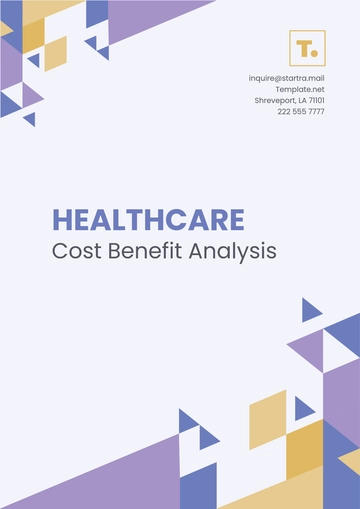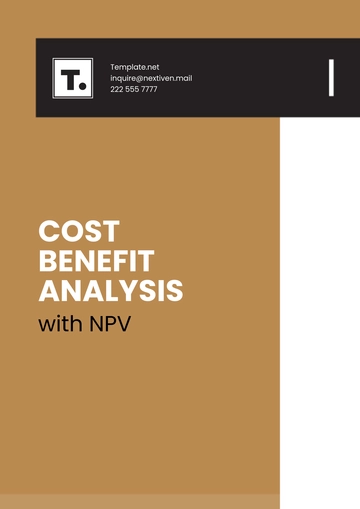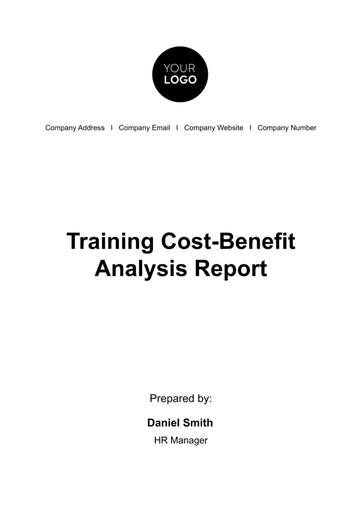Free Business Case Cost Benefit Analysis

I. EXECUTIVE SUMMARY
The purpose of this Cost Benefit Analysis (CBA) is to evaluate the potential investment decision of [YOUR COMPANY NAME] regarding the implementation of a new customer relationship management (CRM) system in 2082. This analysis will provide a comprehensive comparison of the costs involved and the expected benefits, ensuring that the final decision is data-driven and aligned with organizational goals.
II. PROJECT OVERVIEW
Project Name: CRM System Implementation
Project Objectives: Enhance customer engagement, improve sales team productivity, and streamline customer support processes.
Scope: Implement CRM software across all departments to centralize customer data and enable better decision-making.
Timeline: Project start date: January 1, 2082. Expected completion date: December 31, 2082.
Stakeholders: CEO, Chief Technology Officer (CTO), Sales Director, IT Director, Customer Service Manager
The main goal of this project is to improve [YOUR COMPANY NAME]’s customer relationships by providing real-time insights, automating key processes, and enhancing the customer experience.
III. COST BREAKDOWN
Initial Investment Costs:
Capital Expenditure (CAPEX): $500,000
Software Licenses: $120,000
Hardware/Equipment Purchase: $80,000
Infrastructure Setup (servers, networks, etc.): $150,000
Licensing and Legal Fees: $50,000
Ongoing Operational Costs:
Labor Costs (project team, training, etc.): $200,000 per year
Maintenance & Support (software updates, technical support): $100,000 per year
Utilities (server costs, cloud hosting, etc.): $75,000 per year
Training & Development (for employees): $50,000 per year
Contingency Costs:
Unexpected Expenses (e.g., unforeseen technical issues): $50,000
Risk Mitigation: $30,000
Total Estimated Cost: $1,255,000
IV. BENEFIT ANALYSIS
Financial Benefits:
Revenue Increase: $1,200,000 per year (due to improved sales productivity and customer retention)
Cost Savings: $350,000 per year (due to reduced manual processes and improved efficiency)
Return on Investment (ROI): 28% annually
Payback Period: 3.2 years
Operational Benefits:
Efficiency Gains: The CRM system will reduce manual data entry by 50%, freeing up 3 full-time employees annually.
Improved Productivity: Sales teams are expected to close 15% more deals due to improved lead tracking and follow-up capabilities.
Streamlined Processes: Customer service resolution time will decrease by 30%, enhancing customer satisfaction.
Strategic Benefits:
Competitive Advantage: The CRM system will enable [YOUR COMPANY NAME] to offer personalized services at scale, distinguishing it from competitors.
Market Positioning: The company will be positioned as a leader in customer service innovation in its industry.
Customer Satisfaction/Retention: A projected 20% increase in customer retention due to better engagement and service delivery.
V. RISK ASSESSMENT
Risk Identification:
Financial Risks: Potential cost overruns due to unforeseen technical complexities in CRM system integration.
Operational Risks: Disruptions to existing processes during the transition period.
Market Risks: If competitors implement similar systems, the CRM’s impact on competitive advantage may diminish.
Legal and Regulatory Risks: Risk of non-compliance with data protection laws due to improper handling of customer data.
Risk Mitigation Strategies:
Financial Risk Mitigation: Set aside a contingency fund of 10% of the total budget for unexpected expenses.
Operational Risk Mitigation: Develop a detailed change management plan and conduct phased rollouts to minimize disruption.
Market Risk Mitigation: Continuously innovate and leverage CRM data to stay ahead of the competition with targeted marketing campaigns.
Legal Risk Mitigation: Ensure full compliance with data protection regulations and regularly audit data handling procedures.
VI. CONCLUSION AND RECOMMENDATION
Based on the analysis presented in the CBA, the recommended course of action is to proceed with the implementation of the CRM system.
The benefits of the project significantly outweigh the costs, with a positive ROI and a reasonable payback period. Furthermore, the strategic alignment with [YOUR COMPANY NAME]’s long-term goals ensures that this project will deliver substantial value. The identified risks can be effectively mitigated through the proposed risk management strategies.
Therefore, it is recommended that [YOUR COMPANY NAME] proceed with the project, subject to final approval from the stakeholders.
VII. APPENDICES
Appendix A: Cost Estimates
Appendix B: Benefit Calculations
Appendix C: Risk Assessment Matrix
Appendix D: ROI Calculations
- 100% Customizable, free editor
- Access 1 Million+ Templates, photo’s & graphics
- Download or share as a template
- Click and replace photos, graphics, text, backgrounds
- Resize, crop, AI write & more
- Access advanced editor
Create compelling business cases with Template.net’s Business Case Cost Benefit Analysis Template. Fully customizable and editable in our AI Editor Tool, this professional template offers a structured approach to weighing costs and benefits. It’s perfect for justifying investments, securing approvals, and driving data-backed decisions for business success. Get it today!





























